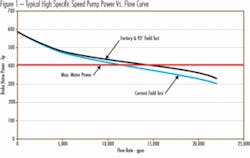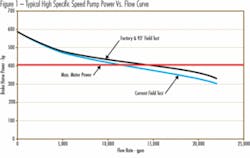Identifying Pumps that Offer Greatest Energy Savings Potential
by Allan Budris
My September 2007 column showed the very large cost savings that are possible with detailed drinking water and wastewater pumping system cost analyses and audits. But given the limited recourses of most pump users, how can we identify the pumps and pumping systems that offer the greatest energy savings potential, with minimum effort?
Answers to the following questions will help identify the most fertile pump applications:
1. Which are the pumps that consume the greatest annual kilowatt hours? Pumps with drivers below 25 horsepower offer little energy savings potential.
2. Does the pump currently have a variable speed drive (VFD)? Savings potential is generally small for a pump that already has a VFD.
3. Is the system performance curve comprised primarily of static head, with little friction head loss? It is hard to justify the cost of a variable speed drive on such a system, since speed reduction is limited. However, substantial cost savings may still be possible with an impeller trim, if an excessive discharge head margin has been applied.
4. Has the system demand been reduced since the pump was initially installed? If the answer to the question is yes, it probably means that there is excess throttling of the control valve and wasted energy.
5. Is the pump control valve normally set at less than 80% open? This means that energy may be saved by trimming the pump impeller(s).
6. Are there multiple pumps operated in parallel? Parallel pumps are often not operated in the most optimum manner and combinations, presenting an opportunity for energy cost savings from a new pump selection / operating plan.
7. Are high specific speed pumps regulated with control valves? High specific speed starts at around 4,000, where specific speed = RPM*(bep Flow -GPM)0.5 / (bep Head - ft)0.75. Pump input power demand and pump head increase quickly as the flow rate is reduced for high specific speed pumps (figure 1.1). This further increases the power loss when these pumps are throttled to lower pump capacities. By-pass control is often more efficient for these pumps.
8. Has the pump performance fallen off, and/or has it been a long time since the last pump overhaul? When pump degradation is in the form of the opening up of internal hydraulic clearances (which can increase pump input power for a given net flow rate), energy savings will result from renewing these clearances. It’s different for pump degradation caused by the roughening of the internal hydraulic passages (such as from corrosion), when the reduced pump performance still meets the system goals, and pump flow is not controlled by a variable speed drive. In this instance, reconditioning the pump may have to be coupled with an impeller trim. Otherwise, little energy savings may result, since the performance gained by reconditioning the pump will largely be lost when the throttle valve is turned down to meet the system requirements. Pump reconditioning would be required, however, if the system goals are no longer being meet, regardless of energy savings.
9. Does the pump currently have an “energy-efficient” or “premium-efficiency” motor? (see figure A1.2) Normally, it is difficult to justify the cost of high efficiency motors as a replacement based solely on the improvement in motor efficiency. The reason is that high efficiency motors often operate at higher speeds than standard efficiency motors, because there is less slip. This higher speed increases the pump head, which means that the control valve must be throttled back to maintain the same flow rate, destroying some of the efficiency savings. Energy-efficient and premium-efficiency motors are easier to justify when the current motor is being replaced for some other reason, such as failure of the current motor, or replacement due to significant over-sizing or under-loading.
10. Are low power factor motors (especially below 60% to 70%), and/or oversized motors, in service? Power factor correction (motor running) capacitors can increase the motor power factor to 95%, which can reduce any utility power factor penalty charges (due to the reduction of reactive current flow from the electric utility, through cables and motor starters). This reduces heat dissipation from these kW losses. Variable Frequency Drives also increase the power factor.
11. Is the control valve undersized, and/or does it have a high pressure drop (low CV-factor design), such as a globe or low CV butterfly valve? Properly sized ball control valves can result in sizable energy savings. Field testing may be required to determine the actual valve pressure drop or CV-factor. Typical control valve CV (or “K”) values are as follows:
While the above does not predict the magnitude of any energy cost savings, it should point users in the direction of the greatest potential. It will help identify the specific drinking water and wastewater pump installations that offer the greatest cost savings opportunities. This is the first step in a facilities-wide energy cost reduction program. Future columns will detail further steps to identify the magnitude of any potential energy cost savings for these prime candidates, and help achieve the calculated life cycles pump cost reduction opportunities for our readers.
Again I encourage questions on your pump problems, to help focus future columns.
References:
1. “Pump User’s Handbook Life Extension”, 2nd Edition, by Heinz P. Bloch & Allan R. Budris, The Fairmont Press, Inc, 2006.
2. “Maximize pump system energy savings”, by Allan R. Budris, Hydrocarbon Processing, May 2006.
About the Author:
Allan R. Budris, P.E., is an independent consulting engineer who specializes in training, failure analysis, troubleshooting, reliability, efficiency audits and litigation support on pumps and pumping systems. With offices in Washington, NJ, he can be contacted via e-mail at [email protected]. Circle No. 277 on Reader Service Card



